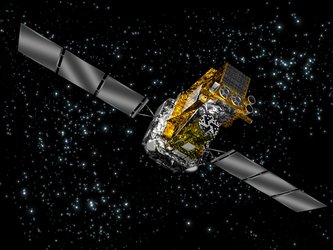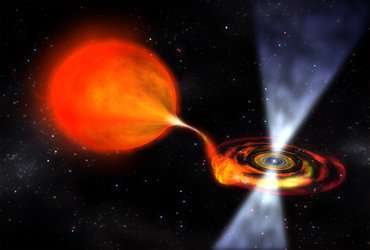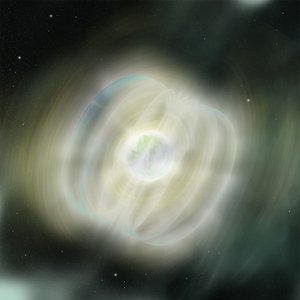Extension of ESA’s Integral and XMM-Newton missions approved
In recognition of their superb scientific output, the mission operations of European flagship x-ray and gamma-ray observatories, XMM-Newton and Integral, have been extended until 31 December 2012.
The extension of both missions, which have been producing an incessant flow of science results since launch, was announced this week after a unanimous vote at a meeting of ESA’s Science Programme Committee.
Integral science highlights
With its sensitive detectors, Integral has accurately measured the hard Cosmic X-ray Background (CXB), responsible for creating the diffuse background glow spread throughout the universe, and it has confirmed that systems containing white dwarves contribute significantly to the galactic hard X-ray diffuse emission.
The gamma-ray observatory has a found a rare class of anomalous X-ray pulsars, with magnetic fields a thousand million times stronger than the strongest steady magnetic field achievable in a laboratory on Earth, and has found massive stars by looking for their radioactive traces - radioactive decay gamma-ray lines from iron have been observed with the most significant detection to date, forcing re-evaluation of existing theoretical models.
Integral has also discovered a new class of X-ray binary stars called super-giant fast transients - X-ray binary systems containing super giant stars. Integral and other high-energy satellites have discovered that these transient systems are not as rare in the galaxy as initially thought.
Although not designed for the purpose, Integral has also proved to be a great gamma-ray-burst ‘watchdog’, providing instantaneous, accurate positions of gamma ray bursts to other facilities within minutes or even seconds. In collaboration with NASA’s Rossi X-ray Timing Explorer, Integral has also detected what appears to be the fastest spinning neutron star yet.
XMM-Newton science highlights

In the last two years XMM-Newton has made breakthrough observations of a wide variety of compact objects, such as the first detection of an intermediate-mass black hole in globular cluster NGC 4472. This has direct implications for the formation and evolution theories of globular clusters in general.
Thanks to its sensitivity at high energies, XMM-Newton has made the first and only direct probing of the central regions near a black hole, by sampling the presence of iron and the variability of its spectral fingerprints. The satellite’s observations have also been fundamental in helping understand the physics of heavy sub-atomic matter (‘baryonic’) in clusters of galaxies and on studying the dark matter component in clusters.
XMM-Newton has given the first strong indication that very faint active galactic nuclei (AGN) are similar to the 'normal' AGN population, and measured for the first time the size of the emission region of an AGN.
Other major results include the progress in understanding the link between X-ray emission and luminosity of stars, as well as the relation between the X-ray emission and processes such as star accretion or collisions.
The satellite has also discovered the remnants of a new class of supernovae within the so-called ‘Ia type’, which are used as standard reference, or ‘candles’, to determine stellar luminosity.
XMM-Newton has also revealed X-ray emission in the Martian exosphere - the first definite detection of X-ray emission induced by exchange of electrical charges from the exosphere of another planet.
Looking towards the future
Science proposals on using these satellites fruitfully in the future have already been submitted, and will continue to be submitted in the future, with an overwhelming response from the scientific community.
Kudos to the teams behind these excellent missions!
Notes for editors:
In December 2005 the XMM-Newton and Integral missions, launched in 1999 and 2002 respectively, had already obtained an extension of their operations until 2010.
Since the beginning of their scientific operations, the number of papers in refereed journals originating from these missions number in hundreds, XMM-Newton at the rate of 300 papers per year and Integral at a rate of 100 per year. There are now in total 1600 refereed papers published based on XMM-Newton data, and more than 300 based on Integral data.
Valuable products from the two missions include X-ray and gamma-ray source sky catalogues – a precious and unique reference for astronomers of the present and next generation.
Among these is the Integral imager (IBIS) survey catalogue, whose third version, compiled from data obtained during the first 3.5 years of the mission, has been recently released. It contains more than 400 high-energy sources, with about 25% of the sources yet to be identified.
Two major source catalogues of XMM-Newton observations have recently been released too: the ‘slew catalogue’ with 4326 sources covering around 20% of the sky, and the 2XMM Serendipitous Source Catalogue with 247 000 detections of 192 000 individual sources, covering a sky area of more than 360 square degrees. The 2XMM catalogue is the largest X-ray source catalogue ever produced.
Last but not least, in the largest survey ever undertaken with the Hubble Space Telescope (HST), called the Cosmological Evolution Survey, the combination of XMM-Newton, HST data and ground-based measurements has resulted in the first 3-dimensional map of dark matter across the survey field and extending back in time by about six thousand million years.
For more information:
Christoph Winkler, ESA Integral Project Scientist
Email: Christoph.Winkler @ rssd.esa.int
Norbert Schartel, ESA XMM-Newton Project Scientist
Email: Norbert.Schartel @ sciops.esa.int















 Germany
Germany
 Austria
Austria
 Belgium
Belgium
 Denmark
Denmark
 Spain
Spain
 Estonia
Estonia
 Finland
Finland
 France
France
 Greece
Greece
 Hungary
Hungary
 Ireland
Ireland
 Italy
Italy
 Luxembourg
Luxembourg
 Norway
Norway
 The Netherlands
The Netherlands
 Poland
Poland
 Portugal
Portugal
 Czechia
Czechia
 Romania
Romania
 United Kingdom
United Kingdom
 Slovenia
Slovenia
 Sweden
Sweden
 Switzerland
Switzerland









































